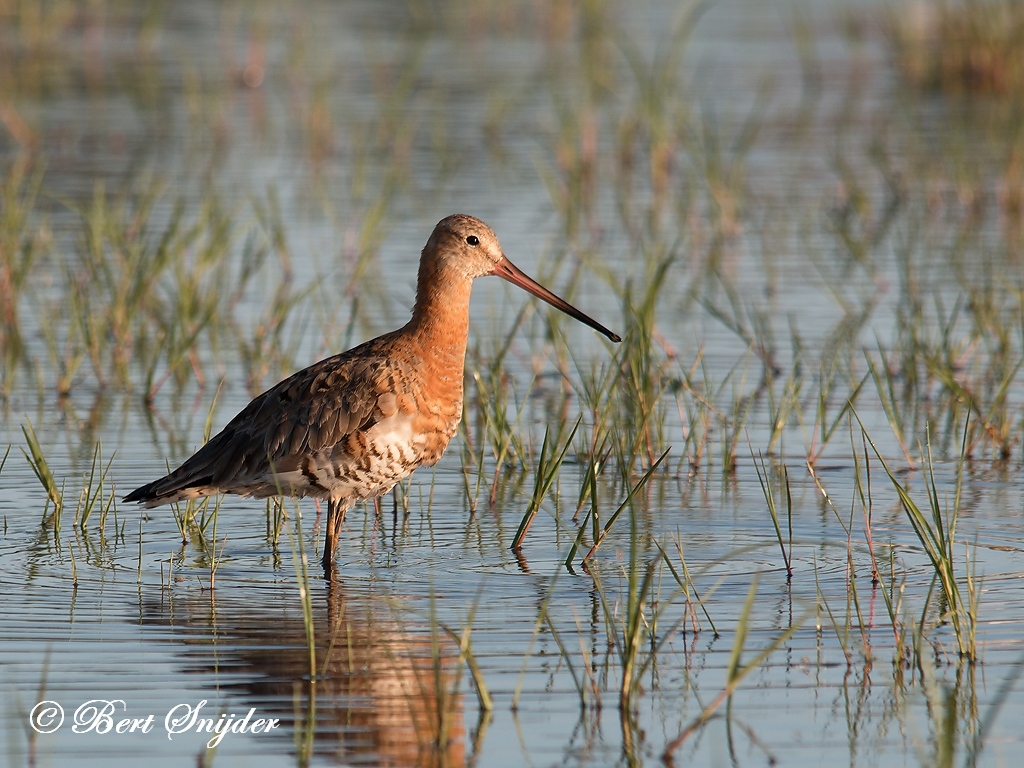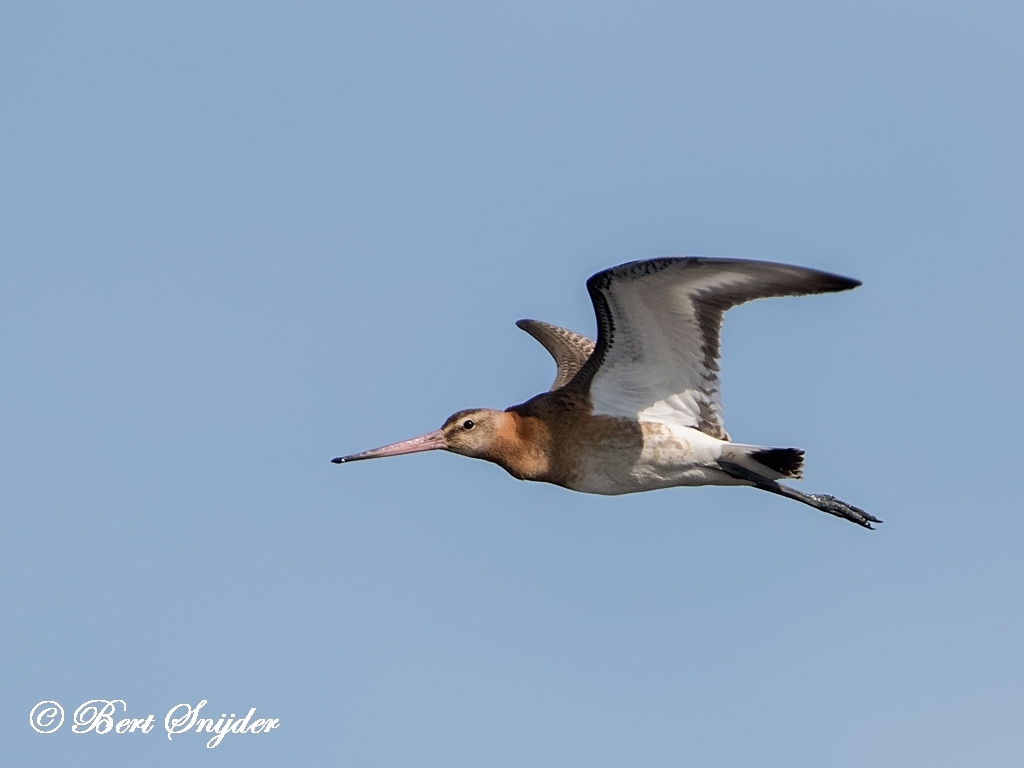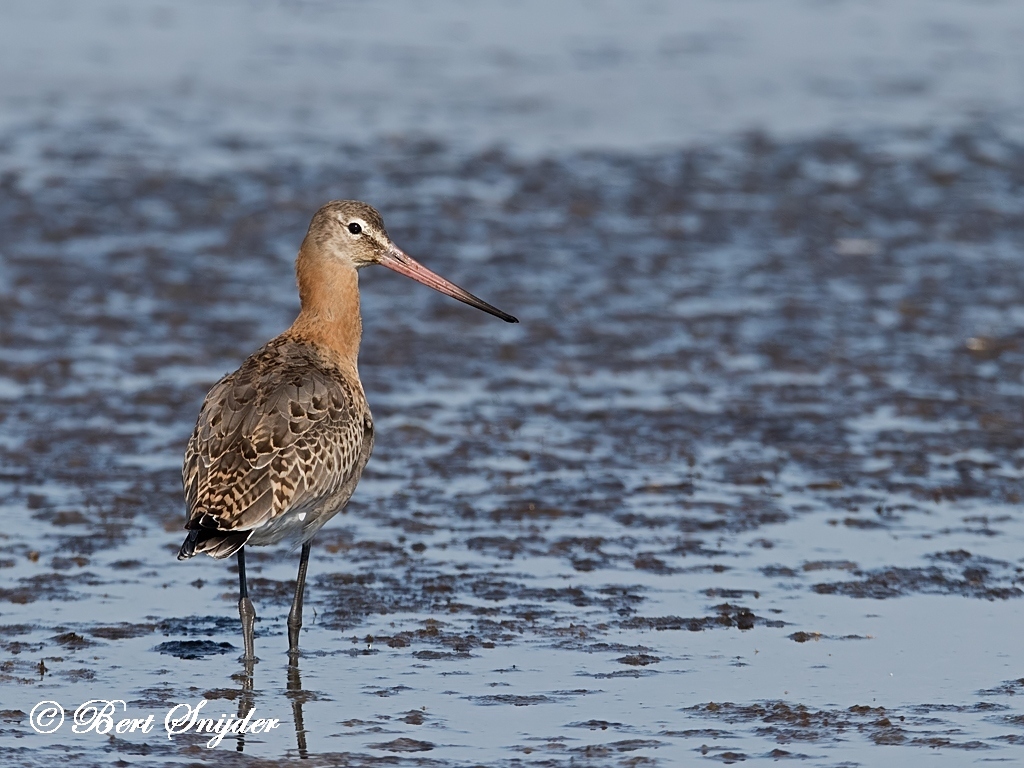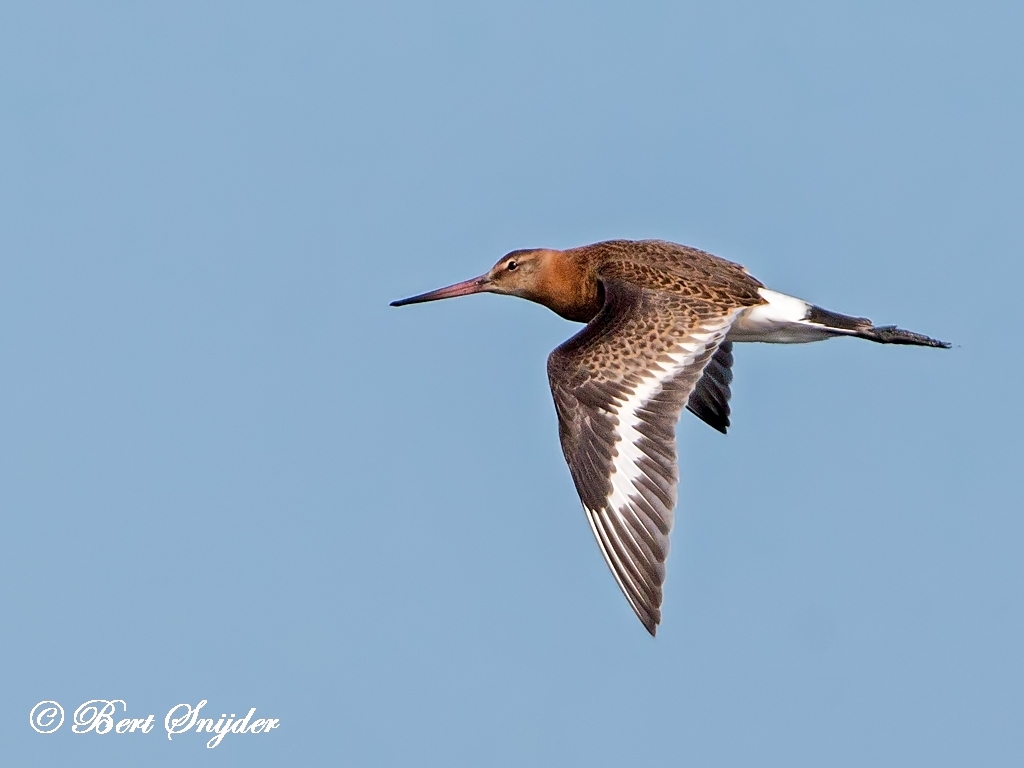Black-tailed Godwit, Grutto, Uferschnepfe, Maçarico-de-bico-direito, Aguja Colinegra
Spotted in the Alentejo region of Portugal. Black-tailed Godwit sound
The Black-tailed Godwit, Limosa limosa, is a large, long-legged, long-billed shorebird first described by Carolus Linnaeus in 1758. It is a member of the Limosa genus, the godwits. There are three subspecies, all with orange head, neck and chest in breeding plumage and dull grey-brown winter coloration, and distinctive black and white wingbar at all times.

More photos at the bottom of this page:
Its breeding range stretches from Iceland through Europe and areas of central Asia. Black-tailed Godwits spend winter in areas as diverse as the Indian Subcontinent, Australia, western Europe and west Africa. The species breeds in fens, lake edges, damp meadows, moorlands and bogs and uses estuaries, swamps and floods in winter; it is more likely to be found inland and on freshwater than the similar Bar-tailed Godwit. The world population is estimated to be 634,000 to 805,000 birds and is classified as Near Threatened.
The Black-tailed Godwit is a large wader with long bill (7.5 to 12 cm long), neck and legs. During the breeding season, the bill has a yellowish or orange-pink base and dark tip; the base is pink in winter. The legs are dark grey, brown or black. The sexes are similar, but in breeding plumage, they can be separated by the male’s brighter, more extensive orange breast, neck and head. In winter, adult Black-tailed Godwits have a uniform brown-grey breast and upperparts (in contrast to the Bar-tailed Godwit’s streaked back). Juveniles have a pale orange wash to the neck and breast.
In flight, its bold black and white wingbar and white rump can be seen readily. When on the ground it can be difficult to separate from the similar Bar-tailed Godwit, but the Black-tailed Godwit’s longer, straighter bill and longer legs are diagnostic. Black-tailed Godwits are similar in body size and shape to Bar-taileds, but stand taller.
It measures 42 cm from bill to tail with a wingspan of 70–82 cm. Males weigh around 280 g and females 340 g. The female is around 5 % larger than the male, with a bill 12-15% longer.
The most common call is a strident weeka weeka weeka. A study of Black-tailed Godwits in the Netherlands found a mortality rate of 37.6 % in the first year of life, 32 % in the second year, and 36.9 % thereafter.
This species was first described, as Scolopax limosa, by Carolus Linnaeus in 1758. Its scientific name is derived from the Latin limus, meaning ‘mud’. The Black-tailed Godwit is a member of the genus Limosa (godwits), family Scolopacidae (sandpipers) and order Charadriiformes, the waders. There are three subspecies:
L. limosa limosa, the European Black-tailed Godwit, which breeds from western and central Europe to central Asia and Asiatic Russia, as far east as the Yenisei River. Its head, neck and chest are pale orange.
L. limosa islandica, the Icelandic Black-tailed Godwit, which breeds mostly in Iceland, but also on the Faeroe Islands, Shetland and the Lofoten Islands. It has a shorter bill, shorter legs and more rufous coloration extending onto the belly, compared to limosa.
L. limosa melanuroides, the Asian Black-tailed Godwit, which breeds in Mongolia, northern China, Siberia and far eastern Russia. Its plumage is similar to islandica, but the bird is distinctly smaller.
Black-tailed Godwits have a discontinuous breeding range stretching from Iceland to the far east of Russia. Their breeding habitat is river valley fens, floods at the edges of large lakes, damp steppes, raised bogs and moorlands. An important proportion of the European population now uses secondary habitats: lowland wet grasslands, coastal grazing marshes, pastures, wet areas near fishponds or sewage works, and saline lagoons. Breeding can also take place in sugar beet, potato and rye fields in the Netherlands and Germany.
In spring, Black-tailed Godwits feed largely in grasslands, moving to muddy estuaries after breeding and for winter. On African wintering grounds, swamps, floods and irrigated paddy fields can attract flocks of birds. In India, inland pools, lakes and marshes are used, and occasionally brackish lakes, tidal creeks and estuaries.
Godwits from the Icelandic population winter mainly in the United Kingdom, Ireland, France and the Netherlands, though some fly on to Spain, Portugal and perhaps Morocco. Birds of the limosa subspecies from western Europe fly south to Morocco and then on to Senegal and Guinea-Bissau. Birds from the eastern European populations migrate to Tunisia and Algeria, then on to Mali or Chad. Young birds from the European populations stay on in Africa after their first winter and return to Europe at two years old. Asian Black-tailed Godwits winter in Australia, Taiwan, the Philippines, Indonesia, and Papua New Guinea.
Black-tailed Godwits are much more likely to be found on inland wetlands than the more coastal Bar-tailed Godwit. They migrate in flocks to western Europe, Africa, south Asia and Australia. Interestingly, although this species occurs in Ireland and Great Britain all year-round, they are not the same birds. The breeding birds depart in autumn, but are replaced in winter by the larger Icelandic race. These birds occasionally appear in the Aleutian Islands and, rarely, on the Atlantic coast of North America.
There is an estimated global population of between 634,000 to 805,000 birds and estimated range of 7,180,000 square kilometres. In 2006 BirdLife International classified this species as Near Threatened due to a decline in numbers of around 25% in the previous 15 years. It is also among the species to which the Agreement on the Conservation of African-Eurasian Migratory Waterbirds (AEWA) applies.
Black-tailed Godwits are mostly monogamous; although it was not recorded in a four-year study of 50-60 pairs, bigamy was considered “probably frequent”. A study of the Icelandic population showed that despite spending winter apart, pairs are reunited on their breeding grounds within an average of three days of each other. If one partner does not arrive on time, ‘divorce’ occurs. They nest in loose colonies. Unpaired males defend a temporary territory and perform display flights to attract a mate. Several nest scrapes are made away from the courtship territory, and are defended from other godwits. Once eggs are laid, an area of 30–50 metres around the nest is defended. The nest is a shallow scrape on the ground, usually in short vegetation. The eggs may be hidden with vegetation by the incubating parent.
The single brood of three to six eggs, coloured olive-green to dark brown, measure 55 x 37 mm and weigh 39 g each (of which 6% is shell). Incubation lasts 22–24 days and is performed by both parents. The young are downy and precocial and are brooded while they are small and at night during colder weather. After hatching, they are led away from the nest and may move to habitats such as sewage farms, lake edges, marshes and mudflats. The chicks fledge after 25–30 days.
They mainly eat invertebrates, but also aquatic plants in winter and on migration. In the breeding season, prey includes include beetles, flies, grasshoppers, dragonflies, mayflies, caterpillars, annelid worms and molluscs. Occasionally, fish eggs, frogspawn and tadpoles are eaten. In water, the most common feeding method is to probe vigorously, up to 36 times per minute, and often with the head completed submerged. On land, Black-tailed Godwits probe into soft ground and also pick prey items from the surface.






Other synonyms:
Afrikaans: Swartstertgriet
Asturian: Abuya de Rau Prietu, Aguya Rauprieta
Azerbaijani: Böyük oxcüllüt
Breton: Ar marc’heg lost du
Catalan: Cegall de mosson, Siglot cantaire, Tètol cuanegre
Catalan (Balears): Cegall de mosson
Valencian: Siglot cantaire
Czech: bøehouš èernoocasý, Brehouš cernoocasý
Welsh: Cwtyn ddu, Rhostog gynffonddu
Danish: Stor kobbersneppe
German: Schlammling, Uferschnepfe
English: Blacktailed Godwit, Black-tailed Godwit
Esperanto: nigravosta limozo
Spanish: Aguja Colinegra, Aguja de Cola Negra, Playero pico curvo, Playero trinador, Zarapito Trinador
Spanish (Argentine): Playero trinador
Spanish (Honduras): Playero pico curvo
Spanish (Mexico): Zarapito Trinador
Estonian: Mustsaba-vigle
Basque: Kuliska buztanbeltz, Kuliska buztanbeltza, Tètol cuanegre
Finnish: Mustapyrstökuiri
Faroese: Koparsnípa, Reyðspógvi
French: Barge à queue noire, Barge à queue noire
Frisian: Skrie, Skries
Irish: Guilbneach Earrdhubh
Gaelic: Cearra-Ghob
Galician: Mazarico rabinegro, Tètol cuanegre
Croatian: Crnorepa Muljaca
Hungarian: Nagy goda
Indonesian: Biru laut ekor hitam, Birulaut Ekor-hitam
Icelandic: Jaðrakan
Italian: Pittima reale
Japanese: oguroshigi, Oguro-shigi, Origo-shigi
Cornish: Godwyt tyndhu
Latin: Limosa limosa
Lithuanian: Griciukas, Paprastasis griciukas
Malay: Kedidi Ekor Hitam
Maltese: Girwiel Prim
Dutch: Grutto
Norwegian: Islandsspove, Svarthalespove
Polish: rycyk, Slonka
Portuguese: Batuira-de-bico-torto, maçarico de bico direito, Maçarico-de-bico-direito, Macarico-galego
Portuguese (Brazil): Batuira-de-bico-torto, Macarico-galego
Romansh: Becassina da riva
Russian: Bolshoy Veretennik
Scots: Cearra ghob
Northern Sami: Cáhppesbaðošguškil
Slovenian: crnorepi kljunac
Albanian: Gjelëza e madhe bishtzezë
Serbian: crnorepa, Muljaca, Muljaca, crnorepa, obicna muljaca
Swedish: Rödspov
Swahili: Msese Mkia-mweusi
Travel Birdwatching Holiday Alentejo, Vacation Portugal for birders. Guided Birdwatching Tours and Trips..